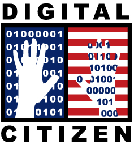Thank you for participating in our tutorial. There is no cost other than the time you invest in learning and sharing what you learn. This tutorial is brought to you by the California School Library Association and California State University Long Beach.
The digital society is here, so what is digital citizenship? Just as we are citizens of a physical country, so are we citizens of the digital world. Just as we need to obey the laws, and not harm anyone, that same spirit exists in the digital world – and it impacts the physical world as well. The mean words and pictures that are posted online, can hurt people in their daily lives at school and in their community.
But citizenship means more than behaving responsibly, it also means that we should be civically engaged: voting, keeping current and having our voice in political matters, and contributing to society. To this end, we need to get accurate information, and decide the verity of political messages that surround us. This same pro-active attitude and behavior also applies to the digital environment. Technology enables us to research significant social issues and to voice our opinions to a global audience.
In short, digital citizenship means the ability to use technology safely, responsibly, critically, and pro-actively to contribute to society.
Digital citizenship is a worthy endeavor, and it is also the law. California AB 307 requires district technology plans to “include a component to educate pupils and teachers on the appropriate and ethical use of information technology in the classroom.” Governor Arnold Scharzenegger’s Executive Order S-06-09 established a California ICT Digital Literacy initiative, asserting that “it is an important goal to ensure that California residents are digitally literate." Similarly, the federal S 1492 Broadband Data Improvement Act (Public Law 110-385), also titled Protecting Children in the 21st Century Act, mandates that all schools receiving e-rate discounts must teach students “about appropriate online behavior, including interacting with other individuals on social networking sites and in chat rooms and cyberbullying awareness and response.”
In short, digital citizenship means the ability to use technology safely, responsibly, critically, and pro-actively to contribute to society.
Digital citizenship is a worthy endeavor, and it is also the law. California AB 307 requires district technology plans to “include a component to educate pupils and teachers on the appropriate and ethical use of information technology in the classroom.” Governor Arnold Scharzenegger’s Executive Order S-06-09 established a California ICT Digital Literacy initiative, asserting that “it is an important goal to ensure that California residents are digitally literate." Similarly, the federal S 1492 Broadband Data Improvement Act (Public Law 110-385), also titled Protecting Children in the 21st Century Act, mandates that all schools receiving e-rate discounts must teach students “about appropriate online behavior, including interacting with other individuals on social networking sites and in chat rooms and cyberbullying awareness and response.”
These acts focus on technological education, especially the K-12 area. The federal act targets minors, and emphasizes web 2.0 activities such as social networking and cyberbullying. The state act includes teachers into the educational mix, and has a more positive spin of ethical literacy and digital citizenship as well as a broader scope. The governor’s order has a lifelong agenda. As such, you will see resources for the entire school community because digital citizenship is a 24/7 endeavor.
The site https://csulblis.libguides.com/K12DigitalCitizenship is a central wiki for digital citizenship. Below is the outline for each module. The links below will take you to the specific learning session. Work at your own pace to explore and do activities to increase your understanding. We encourage you to keep a blog as a means to record and share your experiences.
Module #1: What is digital citizenship?
- Check out one of the PowerPoint presentations to learn about digital citizenship.
- Adapt it for use at your site.
Module #2: What are standards for digital citizenship?
- Link a set of content standards with the model school library standards in light of digital citizenship.
- Brainstorm learning activities that could incorporate both sets of standards.
- Read about ways that students can use technology to get engaged civically.
- Suggest a digital service project.
Module #4: What tools support digital citizenship?
- Try out some tools that can be used to foster digital citizenship.
- Match tools with digital responsibility standards.
Module #5: How can digital citizenship be taught?
- Test a couple of lessons that deal with digital citizenship.
- Try writing your own lesson, or collaborate with a colleague to do so.
- Explore some of the resources that can inform you and your school community.
- Create lists of relevant digital citizenship resources.
